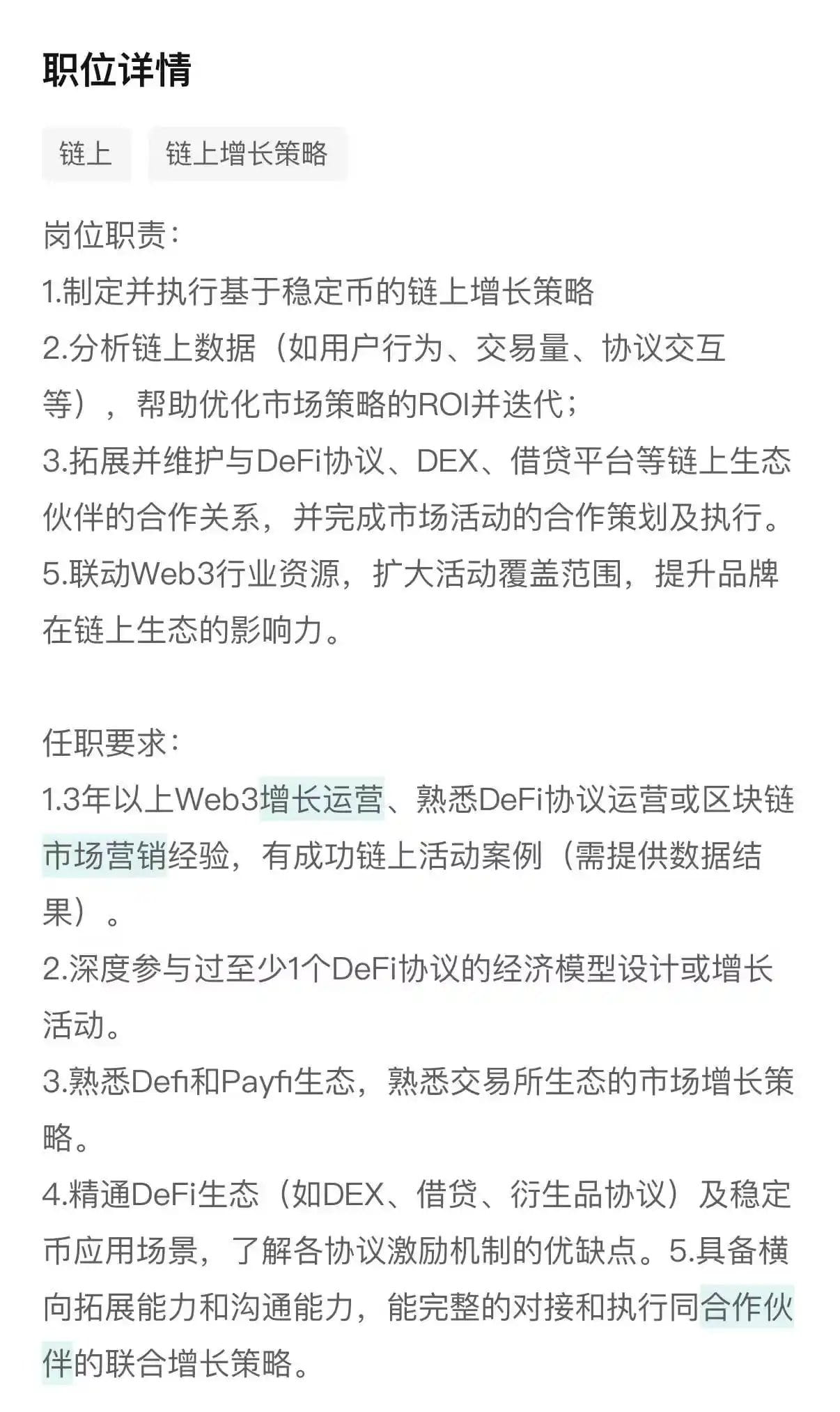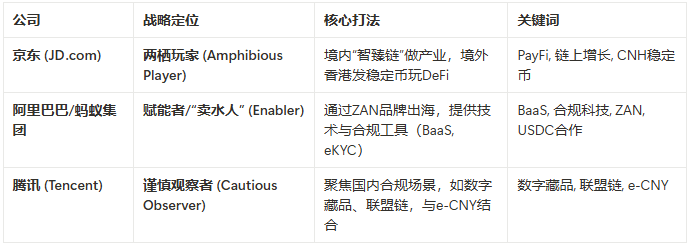Written by: Luke, Mars Finance
A job advertisement can sometimes reveal a company's strategic intentions more clearly than an annual report.
In August 2025, JD Technology's recruitment information was just like that. It did not appear on the homepage of mainstream job sites but circulated quietly in the small circles of Web3. What is striking is not the job title "Stablecoin On-chain Activity Planner" itself but its remarkably "crypto-native" requirements: "Deep participation in the economic model design of at least one DeFi protocol," "Proficiency in DEX, lending, and derivatives protocols."

This is not about finding a fintech expert to optimize internal payments but rather about "hunting" for a true on-chain strategist. When an internet giant with annual revenues exceeding a trillion, rooted in physical retail and supply chains, begins to openly seek talents who can thrive in a decentralized world, the signal it sends is unmistakable: JD is preparing to place its pieces on the global, permissionless Web3 chessboard.
The wind from Hong Kong has arrived, and JD is seizing the opportunity to enter the field.
JD's move did not happen in a vacuum. The timing of the recruitment action precisely echoes a key regulatory reform in Hong Kong.
Just days before the recruitment information surfaced - on August 1, 2025, the long-awaited (stablecoin issuer licensing system) officially took effect in Hong Kong. This means that after multiple rounds of consultations and sandbox testing, the Hong Kong Monetary Authority (HKMA) has laid out a compliant and clearly defined "welcome mat" for global stablecoin operators. Therefore, JD's recruitment can be seen less as an exploration into unknown territory and more as a precisely calculated move, targeting this newly certified, strategically valuable global financial new continent.
The Secretary for Financial Services and the Treasury, Christopher Hui, has repeatedly emphasized in public that: "Under the premise of ensuring regulation and risk control, we support the prudent development of the virtual asset market and view stablecoins as a key bridge connecting traditional finance with the virtual asset market."
This tailwind is timely for tech companies like JD, which have a vast background in mainland China and are eager to connect with global markets. It provides a perfect "outlet" - a strategic point that is legally clear, geographically close, and culturally connected. By establishing a compliant entity in Hong Kong, JD can legally issue stablecoins pegged to fiat currencies (such as offshore RMB CNH or HKD), thus circumventing strict regulations on cryptocurrencies in mainland China and directly participating in global on-chain economic activities.
JD's recruitment was announced right after the regulations took effect, which is no coincidence but rather a long-planned "seizing the opportunity." The chessboard is set, and JD clearly does not want to be just a spectator.
PayFi: Financial Lego Beyond Payments
If Hong Kong's regulatory environment is the "timing" for JD's stablecoin project, then an inconspicuous term in the job description - PayFi - reveals its true "location advantage" and core ambition.
PayFi, short for Payment Finance, is a concept originating from the crypto-native world. It goes far beyond simply "paying with cryptocurrencies"; its core is seamlessly integrating the payment process itself with complex financial services through smart contracts, giving programmability to every flow of funds.
Imagine a scenario in JD's business: a small to medium-sized enterprise supplying JD used to wait up to 90 days to receive payment, creating significant financial pressure. What happens under the PayFi model?
Once JD confirms receipt of goods, the system can generate an on-chain certificate (NFT or fungible token) representing this receivable and send it immediately to the supplier. The supplier does not need to wait 90 days but can instantly use this "digital promissory note" as collateral in DeFi lending protocols to obtain immediate liquidity; or it can even be split and traded as payments to upstream raw material suppliers. The entire process is automatically executed by code, making it efficient, transparent, and cost-effective.
This is the power of the tokenization of Real World Assets (RWA) combined with PayFi, and it is one of the most exciting narratives in the crypto industry for 2025. Jenny Johnson, CEO of asset management giant Franklin Templeton, has stated: "We believe that the tokenization of real-world assets will reshape the entire financial services industry. This is one of the most significant applications of blockchain technology."
For JD, which has a vast merchant base, a complex supply chain network, and billions of users, its internal assets worth trillions - receivables, warehouse receipts, logistics orders, and consumer credit - are ripe for activation. Bringing these assets to life on-chain through stablecoins and PayFi is akin to opening up the body's meridians, releasing energy that will be exponential. This is not only about reducing costs and increasing efficiency in existing supply chain finance but also creating an entirely new, programmable financial infrastructure.
"Amphibious operations": Different paths to Web3 for the giants
JD's clear focus on stablecoins and DeFi has led it down a distinctly different path in the exploration of Web3 by Chinese tech giants. A horizontal comparison reveals an interesting picture:

As shown in the table above, Alibaba's Ant Group appears more like a "water vendor" in its Web3 layout. Its ZAN brand launched in Hong Kong focuses on providing e-KYC (electronic identity verification), AML (anti-money laundering), and other compliance technology components and BaaS (Blockchain as a Service) for Web3 developers. Its strategy is to "empower" others to better "mine gold" rather than engage directly.
Tencent is more cautious, with its actions mostly revolving around areas with clear domestic policies such as consortium chains and digital collectibles, maintaining a considerable distance from the public chain world.
In this context, JD's strategy appears particularly unique and aggressive. It is not content with merely being a technology service provider but has chosen a path of "amphibious operations."
Inland: Its self-developed "Smart Chain" continues to delve into industry blockchain in a permitted environment, serving applications like anti-counterfeiting traceability and digital proof, embracing regulation, and integrating with the digital RMB (e-CNY) to strengthen the compliance foundation of "industrial digitization."
Offshore: It uses Hong Kong as a window to personally become a "player," issuing its own stablecoins, operating its own on-chain ecosystem, directly fishing in the vast ocean of DeFi, and exploring the stars of "financial assetization."
This dual-track strategy ensures both stability and compliance for domestic operations while opening infinite imaginative space for the group's future.
From E-commerce Empire to On-chain Economy
JD's move marks an important turning point. It indicates that the integration of top Web2 giants with Web3 is moving from theoretical discussions and peripheral trials to deep integration into core business.
In the past, people often discussed how Web3 would "disrupt" Web2. However, JD's case may reveal another possibility: not disruption, but "upgrading." Web2 giants will not be easily replaced; they will leverage their massive user bases, rich application scenarios, and strong capital to absorb the technologies and concepts of Web3, evolving into a new, more powerful hybrid form.
Of course, the road ahead is not smooth. From recruiting a position to truly establishing a prosperous on-chain ecosystem, JD needs to overcome multiple barriers such as technological integration, financial compliance, market education, and user habits. It will face scrutiny not only from traditional financial institutions but also fierce competition from the crypto-native world.
However, regardless of the circumstances, when JD, a trillion-dollar commercial giant, begins to adjust its course and enter the deep waters of DeFi, the entire industry should pay close attention. This is not just about the future of one company but may be painting a blueprint for us: how an e-commerce empire can evolve into an efficient, transparent, and global on-chain economy through the bridge of stablecoins. On that day, the endpoint of a transaction will no longer be the completion of payment but the beginning of another phase of financial value creation.

